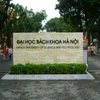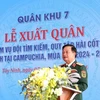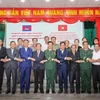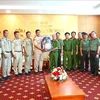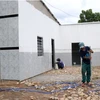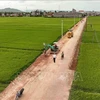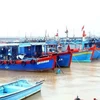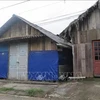The Mekong Delta Rice Research Institute has estimated that summer-autumn crops of the region would generate 9 million tonnes of rice this year, up 120,000 tonnes from the same period last year, despite the reduction in cultivated area.
The Mekong Delta has harvested more than 300,000 hectares of rice to date, representing 18 percent of its rice growing areas.
Average yield of the entire region is estimated around 5.45 tonnes per hectare while that of Can Tho, An Giang and Dong Thap provinces reaches 6.3-6.5 tonnes per hectare.
The wholesale price for paddy rice is around 5,000-5,400 VND (0.23-0.25 USD) per kilogramme. Farmers earn a profit of 27-38 percent of the price as each kilogramme produced costs them about 3,917 VND (0.18 USD).
Mekong Delta provinces have followed a strict schedule of rice farming to avoid drought, flooding and diseases.
Several new cultivation techniques have been spread among local farmers, notably “3 Down, 3 Up” (3 Down: seeds, fertilizers and pesticides; 3 Up: productivity, quality and economic efficiency), and “1 Must, 5 Down” (1 Must: must use of certified rice seeds; 5 Down: decreases in the amount of sowed seeds, in the use of crop protection chemicals, nitrogenous fertilizer and water, and in post-harvest losses).
The provinces focused on growing high-quality rice with more than 85 percent of paddy areas while disease control and irrigation works were well-prepared.
The farmers were also provided soft loans to purchase agricultural equipment for improved cultivation.-VNA
The Mekong Delta has harvested more than 300,000 hectares of rice to date, representing 18 percent of its rice growing areas.
Average yield of the entire region is estimated around 5.45 tonnes per hectare while that of Can Tho, An Giang and Dong Thap provinces reaches 6.3-6.5 tonnes per hectare.
The wholesale price for paddy rice is around 5,000-5,400 VND (0.23-0.25 USD) per kilogramme. Farmers earn a profit of 27-38 percent of the price as each kilogramme produced costs them about 3,917 VND (0.18 USD).
Mekong Delta provinces have followed a strict schedule of rice farming to avoid drought, flooding and diseases.
Several new cultivation techniques have been spread among local farmers, notably “3 Down, 3 Up” (3 Down: seeds, fertilizers and pesticides; 3 Up: productivity, quality and economic efficiency), and “1 Must, 5 Down” (1 Must: must use of certified rice seeds; 5 Down: decreases in the amount of sowed seeds, in the use of crop protection chemicals, nitrogenous fertilizer and water, and in post-harvest losses).
The provinces focused on growing high-quality rice with more than 85 percent of paddy areas while disease control and irrigation works were well-prepared.
The farmers were also provided soft loans to purchase agricultural equipment for improved cultivation.-VNA
